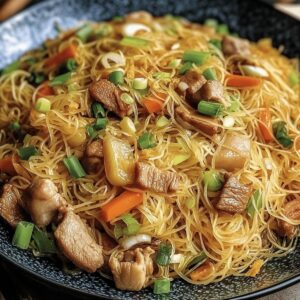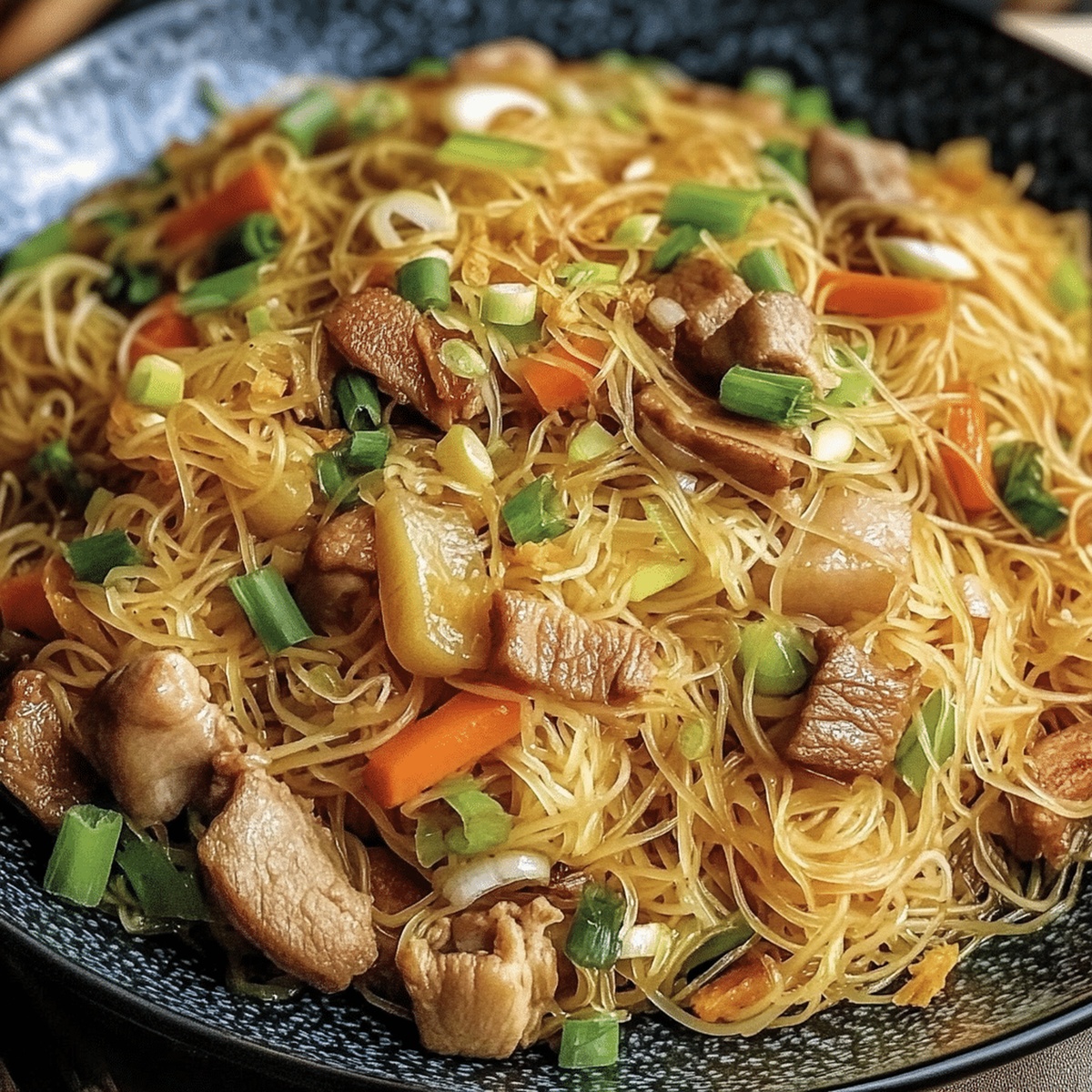Flavorful Journey: Authentic Filipino Pancit Recipe for All
Noodles dance across plates in this mouthwatering Filipino pancit recipe that captures the heart of home cooking.
Generations have cherished this savory pancit recipe passed down through culinary traditions.
Every strand tells a story of comfort and connection.
The blend of vegetables, proteins, and perfectly seasoned noodles creates a symphony of flavors.
Families gather around steaming platters, sharing laughter and memories with each delicious bite.
This classic dish brings warmth and joy to any table.
Your taste buds will celebrate the rich, vibrant essence of Filipino cuisine.
Equipment That Gets the Noodles Just Right
How to Pull Off This Flavor-Packed Pancit Dish
Slide Pancit Canton into hot water and cook until perfectly tender yet slightly firm. Drain and let rest.
Heat oil in a large skillet and cook chicken and shrimp until they’re golden and fully done. Set aside on a plate.
Toss onions and garlic into the same pan until they release their amazing aroma. Add colorful carrots, bell peppers, and snow peas, stirring quickly to keep them crisp and vibrant.
Reunite the cooked protein with dancing vegetables. Pour in chicken broth, soy sauce, and fish sauce. Let everything simmer and mingle for a few moments.
Introduce the cooked noodles to the saucy mixture. Gently toss everything together so each strand gets coated with delicious goodness.
Sprinkle with a pinch of salt and pepper. Squeeze fresh calamansi for a zesty punch. Scatter green onions on top and serve piping hot to eager friends and family.
Adjust This Recipe to Match Your Mood
How to Plate Pancit With Pride
Leftover Pancit? Here’s How to Store It Well
FAQs
Pancit originated from Chinese influence in the Philippines, brought by early Chinese traders who settled in the country. It became a popular dish that Filipinos adapted and made their own.
While Pancit is hearty, it’s typically considered a side dish or light meal. It’s often served with rice or as part of a larger Filipino spread during gatherings and celebrations.
Absolutely! Simply omit the chicken and shrimp, and replace them with tofu or additional vegetables like mushrooms and green beans. The key is maintaining the flavorful sauce and stir-frying technique.
Pancit is uniquely Filipino, featuring a mix of local and Chinese cooking techniques. It uses specific noodles like Pancit Canton and includes distinctive seasonings like fish sauce that give it a distinct flavor profile.
Quick Recipe Overview
Prep Time: 15 minutes
Cook Time: 20 minutes
Total Time: 35 minutes
Calories: 350 kcal
Servings: 7
Everything You’ll Need to Create Filipino Pancit
For Noodle Base:For Protein Ingredients:For Vegetable Medley:For Seasoning Liquids:For Final Touch: Print
Authentic Filipino Pancit Recipe
- Total Time: 35 minutes
- Yield: 7 1x
Description
Savory Pancit noodles showcase the rich culinary heritage of the Philippines with a delightful mix of proteins, vegetables, and aromatic seasonings. Generous portions and simple preparation make this dish a perfect meal for family gatherings and celebrations.
Ingredients
- 1 lb (454 grams) rice noodles (bihon)
- 1 cup (240 grams) cooked chicken, shredded (or pork, sliced)
- ½ lb (226 grams) shrimp, peeled and deveined (optional)
- 4 cups (960 milliliters) chicken broth
- 2 tbsps (30 milliliters) vegetable oil
- 1 medium onion, thinly sliced
- 4 cloves garlic, minced
- 1 medium carrot, julienned
- 1 small cabbage, shredded
- 1 cup (150 grams) green beans, sliced diagonally
- ½ cup (60 grams) celery, sliced
- ¼ cup (60 milliliters) soy sauce
- 2 tbsps (30 milliliters) oyster sauce
- ½ tsp ground black pepper
- 2 green onions, chopped
- 1 lemon, sliced into wedges
- Toasted garlic (optional)
Instructions
- Noodle Preparation: Immerse Pancit Canton noodles in vigorously boiling water, stirring delicately to prevent entanglement. Cook for 3-4 minutes until achieving optimal texture, then drain and rinse with cool water to suspend cooking process.
- Protein Searing: Ignite a wok with vegetable oil over medium-high heat. Swiftly brown chicken and shrimp until they transition from pale to golden, developing a caramelized exterior. Remove protein and reserve on a separate plate.
- Vegetable Transformation: Within the same cooking vessel, caramelize onions and garlic until fragrant. Introduce carrots, bell peppers, and snow peas, tossing rapidly to preserve their vibrant color and crisp texture.
- Flavor Infusion: Reunite cooked proteins with the vegetable ensemble. Stream chicken broth, soy sauce, and fish sauce into the mixture, allowing ingredients to simmer and marry their intricate flavors.
- Noodle Integration: Gently incorporate prepared noodles into the aromatic mixture, ensuring comprehensive coating and seamless distribution of proteins, vegetables, and pasta strands.
- Final Embellishment: Season with salt and black pepper. Enhance with a citrusy splash of calamansi or lemon juice. Garnish with verdant green onion snippets and serve immediately for optimal taste and temperature.
Notes
Prevent Noodle Clumping: Stir gently during boiling and rinse immediately with cool water to stop cooking, ensuring noodles remain separate and perfectly textured.
Maintain Vegetable Crispness: Stir-fry vegetables quickly over high heat to preserve their vibrant colors, crunch, and nutritional value, avoiding overcooking that leads to mushy texture.
Protein Searing Technique: Cook chicken and shrimp at high temperature for a brief period to lock in moisture, creating a golden exterior while keeping the inside tender and juicy.
Balanced Flavor Layering: Add sauces gradually and taste consistently, allowing each ingredient to develop its unique flavor profile without overwhelming the delicate pancit essence.
- Prep Time: 15 minutes
- Cook Time: 20 minutes
- Category: Lunch, Dinner, Snacks
- Method: Sautéing
- Cuisine: Filipino
Nutrition
- Serving Size: 7
- Calories: 350
- Sugar: 2 g
- Sodium: 800 mg
- Fat: 10 g
- Saturated Fat: 1.5 g
- Unsaturated Fat: 8 g
- Trans Fat: 0 g
- Carbohydrates: 50 g
- Fiber: 3 g
- Protein: 20 g
- Cholesterol: 80 mg


John Nicholson
Lead Writer & Recipe Developer
Expertise
Recipe Testing and Development, Kitchen Hacks and Time-Saving Tips, Flavor Pairing and Ingredient Selection, Engaging Food Writing and Storytelling
Education
Johnson & Wales University
John Nicholson honed his skills at Johnson & Wales University, learning how to use fresh, local ingredients and down-to-earth techniques to make cooking simple and satisfying.
His recipes blend Southern comfort flavors with a modern touch, inviting everyone to cook with ease and confidence.
Living in Charleston, John takes cues from the city’s lively food scene, local markets, and seasonal produce. He’s all about making meals stress-free through easy tips, flavor pairings, and fun experiments in the kitchen